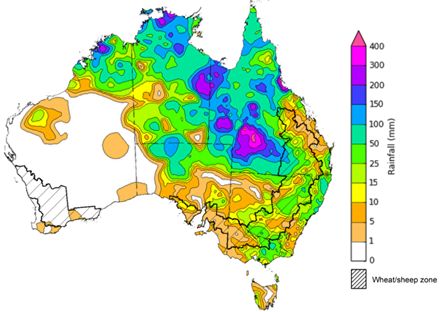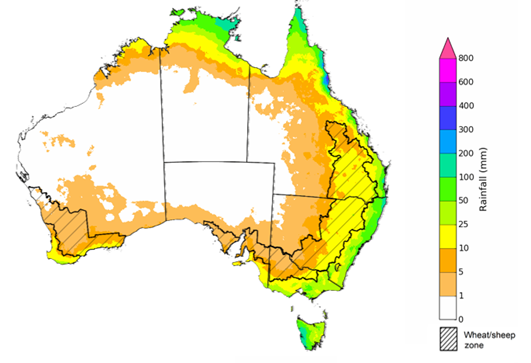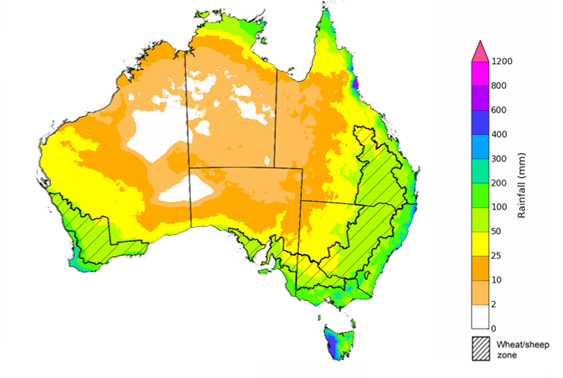Key issues
- In the week ending 27 March 2025 monsoon lows and low-pressure systems brought intense rainfall to the north and east of Australia.
- Large areas of western Queensland recorded rainfall totals of between 100-400 millimetres. While this intense rainfall has led to extensive flooding and possible losses of livestock and farm infrastructure, they are also likely to boost pasture growth, soil moisture and on farm water storage over the months ahead.
- Across cropping regions rainfall totals were high in the east, with between 50- 150 millimetres in western Queensland, while large areas of New South Wales and eastern Victoria observing 5-50 millimetres of rainfall. In summer cropping regions, rainfall totals were generally high. This is expected to see an improvement in stored soil moisture but has likely interrupted the harvesting of crops. Southern cropping regions saw little to no rainfall.
- Over the coming eight days, significant rainfall totals are expected to be received across the north and east of the country.
- Rainfall totals of between 50-100 millimetres are forecast for cropping regions in Queensland, and 100 millimetres in northern New South Wales.
- In Western Australia, South Australia, and western Victoria, rainfall totals are expected to be low. The low rainfall is likely to contribute to a drawdown in soil moisture levels ahead of the planting of winter crops during April.
- The national rainfall outlook for April to June 2025 indicates an increased probability of above median rainfall across the north and east of the country. In contrast, large areas of western and southern Australia are showing an increased likelihood of receiving below median rainfall.
- Relatively dry conditions during summer and early March have seen soil moisture remain well below average across large areas of southern South Australia and western Victoria. Given these well below average soil moisture levels and the increased likelihood of below average rainfall over the next three months, crop producers in these areas will require adequate and timely rainfall to support the sowing and establishment of winter crops.
- Water storage in the Murray-Darling Basin (MDB) decreased between 20 March 2025 and 27 March 2025 by 191 gigalitres (GL). Current volume of water held in storage is 12,287 GL, equivalent to 55% of total storage capacity. This is 28 percent or 4,807 GL less than at the same time last year. Water storage data is sourced from the Bureau of Meteorology.
- Allocation prices in the Victorian Murray below the Barmah Choke decreased from $194 on 20 March to $196 on 27 March. Prices are lower in regions above the Barmah choke due to the binding of the Barmah choke trade constraint.
Climate
In the week ending 26 March 2025, monsoon lows brought intense rainfall to the northern and central regions of the country, while low-pressure systems brought rainfall to the south. High-pressure systems kept much of the remainder of Australia largely dry.
- Parts of the northern tropics, recorded rainfall totals of between 5-300 millimetres, with higher rainfall totals in isolated areas of eastern Queensland.
- Intense rainfall occurred in much of central Australia, including western Queensland (100-400 millimetres), the southern Northern Territory (5-150 millimetres), and northern South Australia (5-150 millimetres).
- While these have led to extensive flooding and possible losses of livestock and farm infrastructure, they are also likely to boost pasture growth, soil moisture and on farm water storage over the months ahead.
- Rainfall totals of between 5-100 millimetres were recorded across much of eastern New South Wales and Victoria. Little to no rainfall was observed in remaining southern and western areas, including southern South Australia, western New South Wales and Victoria, and southern Western Australia.
Rainfall totals were generally low across western and southern cropping regions, but higher in the east.
- In Queensland, western areas recorded 50-150 millimetres, while eastern areas recorded 5-25 millimetres. Meanwhile, New South Wales and eastern Victoria observed 5-50 millimetres of rainfall, with isolated areas seeing up to 100 millimetres
- Western Australia, South Australia and western Victoria saw little to no rainfall over the period.
- In summer cropping regions, rainfall totals were generally high. This is expected to see an improvement in stored soil moisture but has likely interrupted the harvesting of crops.
Rainfall for the week ending 26 March 2025

Issued: 26/3/2025
Note: The rainfall analyses and associated maps utilise data contained in the Bureau of Meteorology climate database, the Australian Data Archive for Meteorology (ADAM). The analyses are initially produced automatically from real-time data with limited quality control. They are intended to provide a general overview of rainfall across Australia as quickly as possible after the observations are received. For further information go to http://www.bom.gov.au/climate/rainfall/
Over the 8 days to 3 April 2025, tropical lows and low-pressure troughs are expected to bring significant rainfall totals to much of the north and east of the country.
- Falls of between 25-150 millimetres are likely for much of northern and eastern Queensland, the Northern Territory, northern Western Australia and much of New South Wales.
- Across parts of eastern South Australia and eastern Victoria, rainfall totals of 10-100 millimetres are expected, while Tasmania is forecast to receive 10-25 millimetres.
- High-pressure systems are expected to keep southern regions largely dry, including southern Western Australia, much of the remainder of South Australia and western Victoria, where rainfall totals of 1-15 millimetres are forecast.
Rainfall totals across cropping regions over the coming week are forecast to be highly variable.
- Rainfall totals of between 50-150 millimetres are expected in Queensland, with northern New South Wales likely to see up to 100 millimetres over the period. Southern New South Wales is expected to see 15-50 millimetres.
- In contrast, cropping regions in Western Australia, South Australia, and western Victoria are expected to see little to no rainfall. Eastern Victoria is expected to see between 10- 25 millimetres.
- If realised, these high rainfall totals across Queensland and much of New South Wales are likely to interrupt harvest of summer crop but are expected to provide a significant boost to soil moisture levels ahead of the planting of winter crops.
Total forecast rainfall for the period 27 March to 3 April 2025

Issued 27/3/2025
Note: This rainfall forecast is produced from computer models. As the model outputs are not altered by weather forecasters, it is important to check local forecasts and warnings issued by the Bureau of Meteorology.
The El Niño Southern Oscillation (ENSO), Southern Annular Mode (SAM), and Indian Ocean Dipole (IOD) climate drivers are currently neutral and having minimal influence on Australian rainfall. The IOD is likely to remain neutral over the coming months. Additionally, the ENSO is likely to remain neutral until July, suggesting these climate drivers will have little impact on Australian rainfall over the coming months.
The most recent rainfall outlook for April 2025 provided by the Bureau of Meteorology indicates that much of northern Australia, and parts of the east, are likely to see above median rainfall. In the west, below median rainfall is more likely, with central and southeast regions having no strong tendency towards either above or below average rainfall.
- The Bureau of Meteorology’s climate model indicate a 75% chance of April rainfall totals between 10-200 millimetres across parts of the far-north, including the Northern Territory, with exceptions in the far-north of Western Australia were between 10-25 millimetres is likely. Parts of northern Queensland are expected to see as much as 400 millimetres.
- Eastern Australia, including southeast Queensland, eastern New South Wales, southern Victoria and Tasmania are likely to see between 10-100 millimetres of rainfall.
- Lower rainfall totals are expected across western, central and southern areas, with much of Western Australia, Northern Territory, South Australia, western Queensland and western New South Wales likely to see little to no rainfall.
- Across cropping regions, there is a 75% chance of rainfall totals of between 5-25 millimetres across most cropping regions in New South Wales and Queensland. Little to no rainfall is expected in remaining cropping regions. If realised, these rainfall totals would be considered below average for this time of year. A lack of sufficient rainfall in April is likely to result in an increased disconnect between upper- and lower-layer soil moisture. This meaning that there may be limited opportunities to plant winter crops under ideal conditions, particularly in some southern growing regions.
Rainfall totals that have a 75% chance of occurring in April 2025

Issued: 20/3/2025
The rainfall outlook for April to June 2025 indicates an increased probability of above average rainfall across parts of northern and eastern Australia. In contrast, large areas of western and southern Australia are showing an increased likelihood of receiving below median rainfall.
Across cropping regions, the chance of receiving above median rainfall is between 35-40% across much of Western Australia, South Australia, Victoria, and southern New South Wales. Much of Queensland is showing and increased likelihood (55–65% chance) of receiving above median rainfall. Meanwhile, across the remainder of New South Wales, falls are more likely to be close to average with no strong tendency towards either above or below median rainfall.
Rainfall totals that have a 75% chance of occurring April 2025 to June 2025

Issued: 27/3/2025
The rainfall outlook for April through to June 2025 suggests a 75% chance of receiving rainfall totals of between 10-200 millimetres across eastern Queensland and the Northern Territory, with rainfall greater than 400 millimetres expected in parts of far-north Queensland. Between 25- 200 millimetres of rainfall are forecast across much of New South Wales, Victoria, southern South Australia and Western Australia, and Tasmania, with greater rainfall totals expected in western areas of Tasmania. In central Australia, little to no rainfall is forecast over the period.
In cropping regions, there is a 75% chance of receiving between 25-100 millimetres. If realised, these forecast rainfall totals would be considered below average for this three-month period across most of Australia. Relatively dry conditions during summer and early March have seen soil moisture remain well below average across large areas of southern South Australia and western Victoria. Given these well below average soil moisture levels and the increased likelihood of below average rainfall over the next three months, crop producers in these areas will require adequate and timely rainfall to support the sowing and establishment of winter crops.
For livestock producers experiencing below average rainfall, particularly across southern Australia, this will likely result in below average pasture production. This is likely to lead to an extended period of feeding supplementary fodder and the carting of stock water to enable producers to maintain current production levels and stocking rates.
Rainfall totals that have a 75% chance of occurring April 2025 to June 2025

Issued: 27/3/2025
Water
Water storages, water markets and water allocations - current week
The Tableau dashboard may not meet accessibility requirements. For information about the contents of these dashboards contact ABARES.
Commodities
Information on weekly price changes in agricultural commodities is now available at the Weekly commodity price update.
